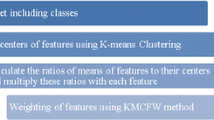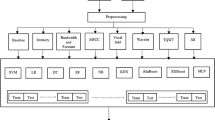Abstract
Parkinson’s disease (PD) is a second most progressive neurodegenerative disorder. Millions of people across the world are affected with this disease. In recent days, there are significant research has been reported for the screening of PD using Dysphonia features. In this study, a new weights generation method named as Kernel Fuzzy C-means Ratio based on different clustering technique (KFCM, FCM and KCM) has been proposed. The main aim of this work is to transform non-separable speech features in the dataset to a linearly separable such that the classification can be enhanced. In classification stage, six different classifiers are used to classify the weighted data and significant improvement in sensitivity, accuracy and specificity parameters are recorded.






Similar content being viewed by others
References
Backman, W., Bendel, D., & Rakhit, R. (2010). The telecardiology revolution: Improving the management of cardiac disease in primary care. Journal of the Royal Society of Medicine, 103(11), 442–446.
McLean, S., Chandler, D., Nurmatov, U., Liu, J., Pagliari, C., Car, J., & Sheikh, A. (2011). Telehealthcare for asthma: A Cochrane review. CMAJ, 183(11), 733–742.
Johnson, N. D. (2010). Teleradiology 2010: Technical and organizational issues. Pediatric Radiology, 40(6), 1052–1055.
Evans, A. J., Kiehl, T.-R., & Croul, S. (2010). Frequently asked questions concerning the use of whole-slide imaging telepathology for neuropathology frozen sections. Seminars in Diagnostic Pathology, 27(3), 160–166.
Demaerschalk, B. M. (2010). Telestrokologists: Treating stroke patients here, there, and everywhere with telemedicine. Seminars in Neurology, 30(05), 477–491.
Booij, J., & Knol, R. J. J. (2007). SPECT imaging of the dopaminergic system in (premotor) Parkinson’s disease. Parkinsonism & Related Disorders, 13(SUPPL. 3), 425–428.
Cummings, J. L., Henchcliffe, C., Schaier, S., Simuni, T., Waxman, A., & Kemp, P. (2011). The role of dopaminergic imaging in patients with symptoms of dopaminergic system neurodegeneration. Brain, 134(11), 3146–3166.
Booij, J., Tissingh, G., Boer, G. J., Speelman, J. D., Stoof, J. C., Janssen, A. G., Wolters, E. C., & van Royen, E. A. (1997). [123I]FP-CIT SPECT shows a pronounced decline of striatal dopamine transporter labelling in early and advanced Parkinson’s disease. Journal of Neurology, Neurosurgery and Psychiatry, 62(2), 133–140.
Nussbaum, R. L., & Ellis, C. E. (2003). Alzheimer’s disease and Parkinson’s disease. Alzheimer’s Disease Parkinson’s Disease, 348(14), 1356–1364.
Parkinson Study Group and Parkinson Study Group. (2002). Dopamine transporter bain imaging to assess the effects of pramipexole vs levodopa on Parkinson disease progression. JAMA, 287(13), 1653–1661.
Mühlhaus, J., Frieg, H., Bilda, K., & Ritterfeld, U. (2017) Game-based speech rehabilitation for people with Parkinson's disease. In International conference on universal access in human-computer interaction, UAHCI 2017, Part III, LNCS 10279 (pp. 76–85). https://doi.org/10.1007/978-3-319-58700-4_7
Little, M. A., Mcsharry, P. E., Hunter, E. J., Spielman, J., & Ramig, L. O. (2009). Suitability of dysphonia measurements for telemonitoring of Parkinson’s disease. Nature Precedings, 56(4), 1015–1022.
Geman, O. (2011). Data processing for Parkinson’s disease: Tremor, speech and gait signal analysis. In International conference E-health and bioengineering (pp. 24–27).
Tsanas, A., Little, M. A., Mcsharry, P. E., Member, S., Spielman, J., & Ramig, L. O. (2012). Novel speech signal processing algorithms for high-accuracy classification of Parkinson’s disease. IEEE Transactions on Biomedical Engineering, 59(5), 1264–1271.
Prashanth, R., Roy, S. D., Mandal, P. K., & Ghosh, S. (2014). Automatic classification and prediction models for early Parkinson’s disease diagnosis from SPECT imaging. Expert Systems with Applications, 41, 3333–3342.
Lee, P. W. H., Wang, Z. J., Palmer, S. J., Mckeown, M. J., & Preprocessing, A. (2007). Spectral clustering of fMRI data within regions of interest: Clarification of L-dopa effects in Parkinson’s disease29th Annual International Conference of the IEEE Engineering in Medicine and Biology Society (pp. 5235–5238).
Bhattacharya, I. (2010). SVM classification to distinguish parkinson disease patients. In Proceedings 1st Amrita ACM-W celebration women computing in India. ACM.
Ozcift, A. (2012). SVM feature selection based rotation forest ensemble classifiers to improve computer-Aided diagnosis of Parkinson disease. Journal of Medical Systems, 36(4), 2141–2147.
Khemphila, A., & Boonjing, V. (2012). Parkinsons disease classification using neural network and feature selection. International Journal of Mathematical and Computational Sciences, 6(4), 377–380.
Ozkan, H. (2016). A comparison of classification methods for telediagnosis of Parkinson’s disease. Entropy, 18, 115.
Acevedo, E., Acevedo, A., & Felipe, F. (2011). Associative memory approach for the diagnosis of Parkinson’s disease. In Mexican conference on pattern recognition (pp. 103–117). Springer.
Viswanathan, R., Arjunan, S. P., Bingham, A., Jelfs, B., Kempster, P., Raghav, S., & Kumar, D. K. (2020). Complexity measures of voice recordings as a discriminative tool for Parkinson’s disease. Biosensors, 10(1), 1.
Cai, Z., Gu, J., Wen, C., Zhao, D., Huang, C., Huang, H., Tong, C., Li, J., & Chen, H. (2018). An intelligent Parkinson’s disease diagnostic system based on a chaotic bacterial foraging optimization enhanced fuzzy KNN approach. Computational and Mathematical Methods in Medicine, 2021, 1–18.
Dao-qiang Zhang, S. C. (2003). Kernel-based fuzzy and possibilistic C-means clustering. In International conference on artificial neural networks (pp. 122–125).
Bezdek, J. C., Ehrlich, R., & Full, W. (1984). FCM: The fuzzy C-means clustering algorithm. Computers & Geosciences, 10(2–3), 191–203.
Pal, N. R., Pal, K., Keller, J. M., & Bezdek, J. C. (2005). A possibilistic fuzzy C-means clustering algorithm. IEEE Transactions on Fuzzy Systems, 13(4), 517–530.
Kanungo, T., Mount, D. M., Netanyahu, N. S., Piatko, C. D., Silverman, R., & Wu, A. Y. (2002). An efficient k-means clustering algorithm: Analysis and implementation. IEEE Transactions on Pattern Analysis and Machine Intelligence, 24(7), 881–892.
Yuan, C., & Haitao, Y. (2019). Research on K-value selection method of K-means clustering algorithm. Multidiscipline Scientific Journal, 2(2), 226–235.
Author information
Authors and Affiliations
Corresponding author
Ethics declarations
Conflict of interest
We declare that this manuscript is original, has not been published before and is not currently being considered for publication elsewhere. We know of no conflicts of interest associated with this publication, and there has been no significant financial support for this work that could have influenced its outcome. As Corresponding Author, I confirm that the manuscript has been read and approved for submission by all the named authors. We have used well known available standard data set. So ethical approval was not required for this study. Because we have not collected new data or perform any experiment for this study. All authors approved the final version of the manuscript and agree to be accountable for all aspects of this work.
Additional information
Publisher's Note
Springer Nature remains neutral with regard to jurisdictional claims in published maps and institutional affiliations.
Rights and permissions
About this article
Cite this article
Khare, V., Singh, M. Performance Analysis of Different Classifiers for Tele-Diagnosis of Parkinson’s Disease. Wireless Pers Commun 122, 331–348 (2022). https://doi.org/10.1007/s11277-021-08901-6
Accepted:
Published:
Issue Date:
DOI: https://doi.org/10.1007/s11277-021-08901-6




